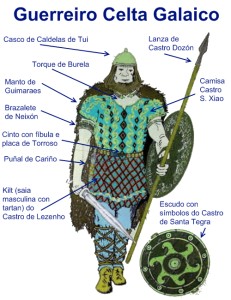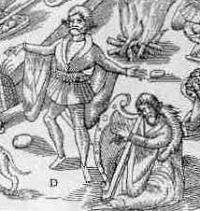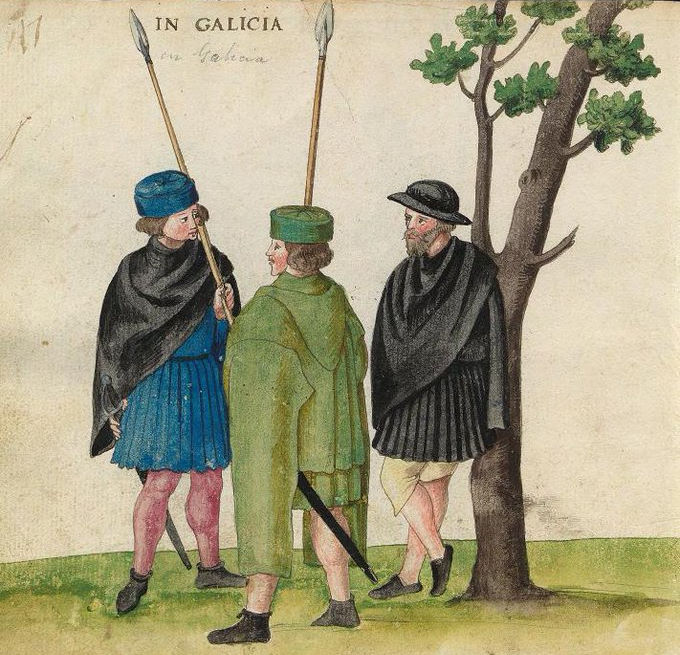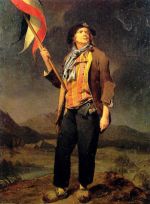
HOME TARTAN HISTORY KILT HISTORY WEARING KILT GALLAECIA
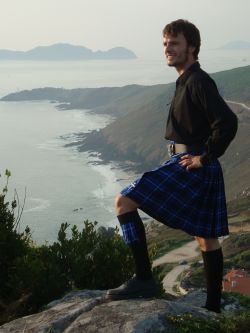 |
This page is about Kilt, a knee-length male skirt. If you are looking for information about tartan (a pattern consisting of criss-crossed horizonal and vertical bands in multiple colours), please visit History of Tartan.
This page contains the following sections:
+ What is a Kilt?
+ Was the kilt originally invented in Galicia?
+ The male skirt in ancient Atlantic Europe
+ New times, new fashions: the arrival of the trousers
+ Kilt revival in post-Jacobite Scotland
+ Kilt revival in the Celtic nations
What is a Kilt?
The Kilt is a knee-lenght type of male skirt, which became an essential part of the Scottish national dress since the 18th century and was re-introduced in the rest of the Celtic nations as part of the Celtic revival of the 20th century.
The Kilt is is internationally renowned as Scotland's national dress and therefore most people believe that the garment was originally created in Scotland. However, male skirts were common fashion in Atlantic Europe from ancient times up until the introduction of the trousers in the 16th century.
In Galicia, male skirts were worn up until the 18th century. In much earlier times, dated from the 3rd century BC, archaeologists have found several statues of Galician kings wearing a primitive kilt which shows clearly a tartan pattern consisting of criss-crossed horizontal and vertical bands.
Was the kilt originally invented in Galicia?
Some Irish authors maintain that the male skirt made in tartan fabric was originally dressed in Ireland, and that from there it was introduced in Scotland after Irish-Scots tribes settled in Caledonia around the 5-6th century A.D. The alleged Irish predecessor of the Scottish kilt was called Léine and was a kind of long tunic that stretched down to the knees.
Scottish historians do not agree with their Irish cousins and believe that the real predecessor of the kilt was not the Irish Léine but the Scottish Plaid. The Plaid is a short tartan blanket which is cast over the shoulder and fastened around the waist by a belt. This was worn mainly in the Scottish Highlands as an all-weather outfit that also served as a bedroll for sleeping outdoors.
Both Scots and Irish can claim to be right in their own ways, for the Highland Plaid could indeed have evolved to a shorter garment -the kilt- and the Irish Léine was a knee-length garment which was dressed long before the modern kilt. Yet, long before the Irish were dressing their Léine and Scots were wearing their Plaid, the Galicians were already wearing knee-length male skirts made in tartan: the first Kilt ever recorded!
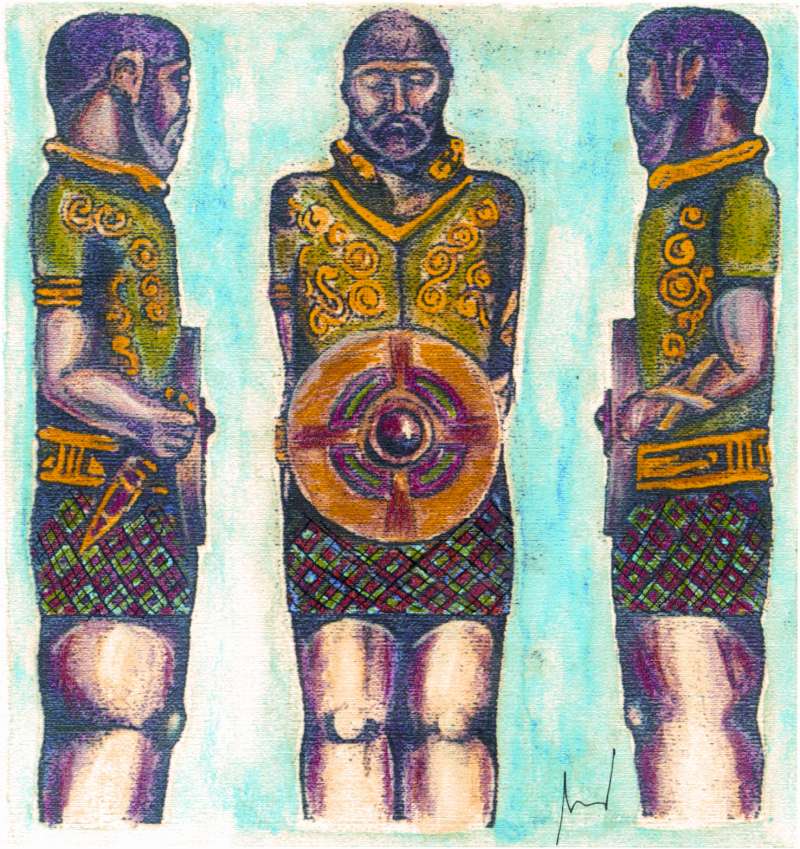
Statue of Galician King or "Princeps", who ruled in the lands
around Lezenho in southern Gallaecia ca. 400 B.C. Drawing made
by André Pena
[Enlarge image]
Those Galician kings are portrayed in a military fashion, in the same way that many mediaeval kings and earls, wearing their sword and shield. But the striking thing about those statues is the way they are dressed. Those men are wearing kilts, over which distinctive patterns of squares and lines are carved as to represent a primitive tartan fabric.
The Galician statues were carved more than five centuries before the first record of the Irish Léine, and almost two millenia before the modern Scottish Kilt.
Moreover, Ancient Gaelic mythology (Irish, Scottish and Galician) tell that the Gaelic tribes of Ireland and Scotland descend from a great migration of Gaels who departed from Brigantia, in the North-West of Galicia. This has been supported by modern DNA research confirming that the original peoples from Ireland, Scotland and Galicia share a common genetic ancestry.
Considering that the Galicians were wearing kilts as early as the 3rd century B.C. and that Galician Gaels settled in Ireland and kept maintaining trading relations between the two lands ever after, some Irish and Scottish historians may want to review their position and accept that the first record of a man wearing Kilt (as a male skirt made in tartan cloth) is neither Irish nor Scottish, but Galician!
The male skirt in ancient Atlantic Europe
 Galician king from San Julião Celtic Hillfort, 3rd century B.C. Drawing by André Pena. [Enlarge image] 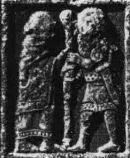 Tunic and Léine. Carving from Clonmacnois Monastery, Ireland, 6th century AD. [Enlarge image] |
Moreover, There is archaeological proof showing that tartan had been known for almost 4,000 thousand years all across Atlantic and Central Europe.
Dated from the 3rd century BC, archaeologists have found several statues of Galician kings wearing male skirts or primitive kilts, with those kilts showing clearly a tartan pattern consisting of criss-crossed horizontal and vertical bands.
 Galician tombstone carved during the period of the Roman occupation. The stone, exhibited at the Quiñones Museum in Vigo, shows a man wearing kilt and holding a weapon under a Celtic cross. [Enlarge image] |
Although the Celtic upper classes ended up replacing the old male skirt by the more fashionable tunic, many common folk may have been wearing the male skirt in combination with a plaid for many centuries longer.
Sea trade and exchanges with the rest of Europe brought the new Greco-Roman tunic fashion into Ireland as well. The result of this may have been the Léinte, which was a kind of long shirt that reached down to the knee.
From Ireland, the Léine was allegedly introduced in Caledonia following the migration of the Scotii tribe during the 5th-6th centuries AD. This has given grounds for some authors to claim that the modern Scottish kilt is an evolution of the Léine, although many others maintain that the real predecessor of the kilt was not the Irish Léine but the Scottish Plaid.
As with any other garment, the Greco-Latin tunic also became out of fashion. New fabrics and new fashions were introduced in Western Europe during the Middle Ages.
During the mediaeval period it was still common for men to wear male skirts in combination with light hoses underneath.
The mediaeval fashion was in turn followed by even more sophisticated garment designs that came to Europe during a new era of colonial expansion and intensification of trade with Asia.
 18th century painting of a Galician wedding in the city of Tui, where the groom and the piper appear wearing kilts. [Enlarge image] |
Male skirts were worn in Ireland at least as late as the 17th century, while Galician men wore a kilt-type garment until the end of the 18th century.
Only in Scotland the kilt survived as a commonly worn garment, thanks to the 19th century Scottish cultural revival.
The social acceptance of the kilt as a masculine fashion garment was boosted as the kilt was adopted as the official uniform of the Scottish Highland regiments, and specially as the Scottish clan chieftains and British royals started to wear kilts in social events and receptions.
[Enlarge image]
New times, new fashions: the arrival of trousers
In the Middle Ages men started to wear light hoses under the tunic or the masculine skirt, but trousers as we know them today were only introduced in Atlantic Europe around the 18th century.
From there onwards the trousers became the standard garment in masculine fashion and the kilt became definitely obsolete in most of Atlantic Europe.
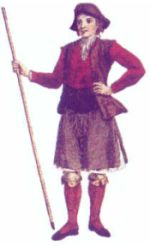 18th century painting of a man from the city of Betanzos, still wearing the kilt at a time when trousers fashion was arriving to Galicia [Enlarge image] |
The modern Galician national costume dates back from the late 18th century, when the trousers had eventually displaced the masculine skirt in daily wear.
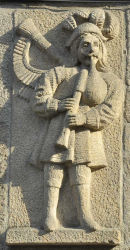 Sculpture of a Galician piper with a short tunic or leine, Pontevedra, probably 16th-17th century. [Enlarge image] |
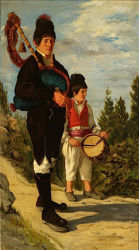 First paiting of a Galician piper wearing short trousers: Mr Farruco of Montrove, second half 19th century [Enlarge image] |
There is however evidence of the wearing of the kilt in Galicia up until the 18th century, such as the portrait of a man from the city of Betanzos who appears wearing kilt, or a 18th century painting of a wedding in the city of Tui, where the groom and the piper also appear wearing a masculine skirt.
Kilt revival in post-Jacobite Scotland
In 18th century Scotland the kilt was a rural garment worn only by people living in the Highlands. Urban Scotland was following the fashion codes which were standard in Europe at the time.
In 1746 the Jacobite army supporting Scotland's royal pretender Bonnie Prince Charlie was defeated at the Battle of Culloden. Since many Highland men fighting for the Jacobites were dressed in tartan and kilt, the British government decided to forbid the wearing of tartan as that could be interpreted as a sign of support for the Jacobite rebellion.
The prohibition of wearing tartan lasted for 36 years until it was abolished in 1782. Inevitably, the ban backfired and the ancient kilt-and-tartan Highland fashion was immediately promoted as Scotland's national dress during the 19th century Scottish cultural revival.
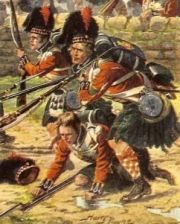 Scotland's best known regiment, The Black Watch, fought alongside the Galicians in the Battle of Corunna, 1808 [Enlarge image] |
One of the very first places in Europe to see kilted soldiers in action was Galicia, where the Scottish Black Watch regiment fought alongside the Galicians against the French in the Battle of Corunna in 1808.
Some years later, Scottish writer Sir Walter Scott convinced King George IV of Great Britain to dress in "the garb of old Gaul" during his 1822 State visit to Scotland.
Sir Walter Scott told the King that he should wear the kilt during his State visit to Scotland in order to gain the respect of the Scottish people who had formerly supported the Jacobite cause.
At the same time Sir Walter Scott -who was in charge of organising the Royal visit- told the guests that they were expected to dress in the Highland fashion, as the King would do himself.
 Modern Scottish dress, incorporating elements of the 20th century European fashion like the tie and jacket. [Enlarge image] |
Sir Walter Scott moved rapidly and printed an instruction booklet so the Scottish urban nobility would know how to dress in the Highland fashion in time for the Royal reception.
The Royal event in Edinburgh was a full success and ever since then, the kilt has been an essential part of the Scottish national dress and has been most commonly associated with all things Scottish.
The way the kilt is worn has evolved significantly over the past century. Some people wear it in a "traditional" style with plaid and jacobite shirt, as in the old Highland fashion. Some others prefer to dress it in a more sophisticated manner, incorporating elegant elements of the contemporary European fashion such as the tie and the suit jacket.
Following the Scottish experience, the kilt was also reintroduced to a lesser degree in the other Celtic nations during the 20th century revival for all things Celtic.
Kilt revival in the Celtic nations
Cultural and economic exchanges among the Celtic peoples have been part of daily life in Atlantic Europe for over two millenia. But international relations are not a thing of the past, so business and cultural exchanges among the 21st century Celts are indeed very much alive today.
Since the kilt was adopted as the Scottish national dress, the garment started to catch the eye of other Celtic cousins in Ireland, Wales, Galicia, Brittany and Cornwall.

Portrait of the children of the House of Jaspe-Moscoso,
Barallobre Manor House, Co. Ferrol, Galicia, 1857. The
girl, Carmen, dressed in white, while her brother Antonio
wears the kilt
[Enlarge image]
The Welsh soon followed the Irish in importing the Kilt as another icon of the modern Celtic and Welsh identity. The most popular Welsh tartan is the Welsh National, which consists in a simple pattern of green, red, and white threads, as in the colours of the Welsh national flag.
Galicians, Bretons, and Cornish were next to adopt the kilt as a fashion garment for modern Celts.
The Cornish and the Bretons have their Cornish National and Brittany National tartan respectively. The Cornish National tartan combines Cornwall's black and white colours, as well as a yellow background to represent the ancient dynasty of Cornish kings. The Brittany National tartan is made in a variety of dark and white tones, as inspired in the black and white colours of the Breton flag.
The Galicia National tartan, also known as Tartan Gallaecia, is Galicia's most popular tartan. Tartan Gallaecia combines white and blue threads as in the colours of the national and historical flags of the country. The tartan's cobalt blue threads represent Galicia's national colour and the navy blue threads represent the Atlantic ocean. The silver threads on the tartan represent Galicia's stormy seas, as well as the white snow on the Galician Highlands and the nation's thousand rivers.
 A
group of friends wearing the kilt at Bardaos' St Pipote Festival A
group of friends wearing the kilt at Bardaos' St Pipote Festival |
* * * * * *
HOME
TARTAN
HISTORY KILT
HISTORY WEARING
KILT GALLAECIA
